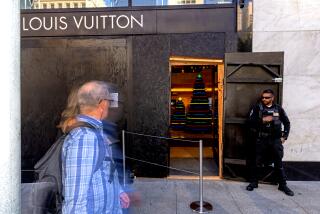Lack of Vigilance on Theft Is a Real Crime
- Share via
He was busy in the yard, busy in the house. Back and forth, forth and back. In the garage, out of the garage. In the house, out of the house.
Ah, the bliss of household chores on a day off.
Problem was, the next time Dan Christian went to ride his bike, it was long gone, snagged by yet another opportunistic burglar in the few minutes Christian was in the backyard.
Reducing the risk of burglary seems simple enough: Close the garage door, lock the windows, get a dog or stronger locks. Lock the car, trim the hedges, improve outdoor lighting, have someone pick up the mail while you are away.
Easy, sure. But too often easier to forget. Just ask burglary victim Christian. He forgot. And he is a property crimes detective in the Oxnard Police Department.
“You leave the garage door open,” he said, “you go in the backyard, and it only takes a matter of seconds for somebody to pick your bicycle up.”
To be sure, Christian is not alone. Nonviolent property crimes--burglary, theft, auto theft and arson--by far account for the largest percentage of crime police departments confront.
A spot check of the April police log in Ventura showed a handful of car and home burglaries that amounted to huge losses in jewelry, tools, bicycles, sports equipment, cellular telephones and clothing. One burglar even stole the car ashtray.
In 1996, countywide statistics show, more than 87% of the crimes committed were property crimes.
And even as law enforcement agencies across the county and nation report significant declines in property crime, officials say homeowners shouldn’t be fooled into letting down their guard.
The financial losses still translate into millions of dollars each year across Ventura County, authorities say.
“Don’t leave your toys unattended,” said Ventura Police Sgt. George Morris, who heads the department’s property crimes division. “I think they taught us that in kindergarten.”
So who are these crooks?
Police say many are drug addicts who can turn VCRs, bicycles, tools and jewelry into quick cash or trade the merchandise directly for more drugs.
These days, popular cellular telephones can bring a thief a quick $50 or can easily be traded for drugs.
Police warn people to engrave their belongings with their driver’s license number and keep records of serial numbers.
Christian said police receive records of all items sold to pawnshops. But if a serial number does not correspond to one included in a burglary report, police are unable to know the item is stolen.
“What we find is that, with stereos, televisions and stuff, most people don’t keep their serial numbers,” Christian said.
*
But it’s not always drug addicts who burglarize cars and homes. The average home burglar in the United States is a 14- to 17-year-old who strikes between 10 a.m. and 2 p.m., said Laura Robinson, Ventura police crime prevention officer.
Often, the kids aren’t out looking to steal things. They simply can’t resist the temptation to steal something left ripe for the plucking in a frontyard or an open garage, police said.
For four years, those open garage doors mocked Ventura County Sheriff’s Deputy Greg Tougas as he patrolled the streets of Thousand Oaks at night.
He could surmise by the cars that the residents were home. They just forgot to push the button on the automatic garage door.
So call Tougas the king of crime prevention, or maybe just a tad on the overzealous side. In the dead of night, he would sneak into the garages, push the button and run like the dickens.
Mission accomplished. Invitation to would-be thieves rescinded.
Today the power of Tougas’ index finger has been replaced by the power of persuasion. He is one of two crime prevention officers in the city, going from meeting to meeting to preach home safety.
It must be working. The most recent crime statistics in Thousand Oaks show home burglaries at 1971 levels, a time when the city’s population was a third smaller.
Last year, there were 239 residential burglaries, just one more than there were 25 years before. Home burglaries peaked in 1978 with 751 incidents, followed by 721 in 1984.
“A couple of years ago, we had professionals,” said Tougas, who has worked in crime prevention for the past year and a half. “They were so good, they’d see a $2,000 bike and a $500 bike, and they’d leave the $500 bike.” Across the county, law enforcement agencies have programs aimed at helping residents avoid becoming victims.
*
In most areas, residents can make appointments with law enforcement agencies for free home security checks, which look at lighting, landscaping, doors, windows and locks and include recommendations on how to beef up home security.
In Ventura, Operation I.D. lets residents borrow engravers or buy one for $10. Participants also get stickers for front windows and belongings that officers say can deter criminals.
In Simi Valley, police officials in 1981 were the first in the county to shine a spotlight on the design of new housing tracts. Police officials sit on development advisory committees, attend Planning Commission meetings and review all new developments right down to the deadbolts. Other agencies across the county make similar efforts to prevent crime before a neighborhood is even built.
Still, despite the best-laid plans and most active Neighborhood Watch groups, many people simply forget to do the simple things. Like lock the door.
About three-quarters of property crimes are committed by burglars who simply slip through open and unlocked windows and doors, Robinson said.
“We still have a small-town mentality toward crime,” she said. “We don’t protect ourselves very well. . . . It’s easier for people to ignore it and feel quasi-safe in their environment.”
About a year ago, Sheriff’s Deputy Leslie Daily and her partner conducted an experiment during their overnight shift in the Ojai Valley.
To see how well residents on their beat were protecting themselves, the deputies checked 25 cars in an Oak View neighborhood. Eighteen of them had unlocked doors or open windows. One car, window down, had an expensive cellular phone sitting on the front seat.
*
“It was amazing,” said Daily, now a deputy in the department’s west county crime prevention bureau. “Too bad we don’t live in a perfect world where you can leave your doors open and your car unlocked. It’s a constant battle.”
Officers credit Neighborhood Watch groups for declines in property crime. Such groups typically form in the aftermath of a crime.
For example, after a rape in January at the Thunderbird Mobile Home Park in Thousand Oaks, about 200 people packed a Neighborhood Watch meeting. Not long after, crime prevention officers conducted about 40 home safety checks at the park.
But often, once residents regain a sense of normalcy, they lose their enthusiasm for the program.
“As crime goes away, they go away,” Tougas said.
But not always.
Take Jason Karpf’s Thousand Oaks neighborhood.
He and his neighbors started a Neighborhood Watch group. They drew a map of their housing tract along with the phone numbers of every neighbor willing to participate.
Neighbors have forged new friendships and get together for meetings and barbecues, said Karpf, a Hollywood transplant to the Conejo Valley.
“When you live [in Hollywood], you reconcile the way things are,” he said. “In Thousand Oaks, we felt we had recourse. And I’m glad to say we were right.”
(BEGIN TEXT OF INFOBOX / INFOGRAPHIC)
Crime Prevention Tips
* Buy supplemental locking devices for windows. Look for devices that stop a window from popping out or sliding open.
* Install deadbolts on all doors.
* Etch driver’s license number onto valuable property to improve chances that stolen goods will be returned. Keep a list of serial numbers at a neighbor’s house or in security deposit box.
* Consider buying a dog.
* Ensure that the street address is posted on the mailbox, street and garage.
* Light up the numbers on the garage.
* Install motion detectors, or floodlights, preferably to shine from all four corners of the house.
* Erect a boundary fence as a “first line of defense.” Make sure it’s a fence that patrolling officers can see through.
* Check shrubbery to see if it can be a potential hiding place. Cut all bushes to below the windowsill. Plants should also be trimmed at the ground so the feet of someone attempting to hide would be visible. Consider thorny plants, such as rose bushes and bougainvillea.
* Make sure the front door has a peephole with a panoramic view and the hinges are on the inside of the house. A medium to high security strike plate should be installed with 3- to 4-inch screws to prevent jimmying.
Source: Ventura County Sheriff’s Department.
More to Read
Sign up for Essential California
The most important California stories and recommendations in your inbox every morning.
You may occasionally receive promotional content from the Los Angeles Times.










